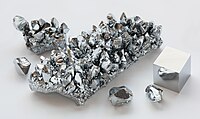
Photo from wikipedia
Abstract The optical absorption, photoluminescence, and electron spin resonance spectroscopies were used to investigate the effect of Bismuth oxide on a chromium doped borate glass system of composition 14.5% Li2O… Click to show full abstract
Abstract The optical absorption, photoluminescence, and electron spin resonance spectroscopies were used to investigate the effect of Bismuth oxide on a chromium doped borate glass system of composition 14.5% Li2O – 0.5% Cr2O3 – (85-x)% B2O3 – (x)% Bi2O3, x = 0.0, 1.0, 3.0, 5.0 and 8.0, synthesized by conventional melt quenching technique. Two sets of Cr characteristic absorption bands were identified in the ultraviolet and visible regions. The intensity and/or peak position for these transitions could be readily tuned through Bi2O3 additives. The ligand field analysis applied to the absorption spectra revealed high field sites for Cr ions as inferred from the resulting Dq/B values. The presence of Cr6+ and Cr3+ ions is further supported by the development of well-defined photoluminescence peaks. The electron spin resonance spectra complement these optical findings and clearly identify resonance signals ascribed to Cr3+ and Cr5+, the latter in particular evolves monotonically with Bi2O3 content.
Journal Title: Journal of Non-crystalline Solids
Year Published: 2021
Link to full text (if available)
Share on Social Media: Sign Up to like & get
recommendations!